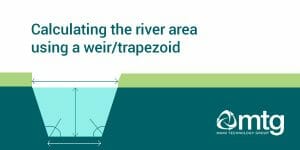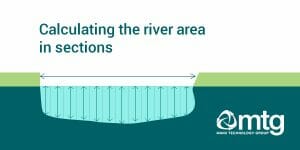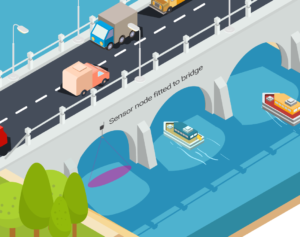
The ongoing climate threat has strengthened the need to measure river flow rates. River flow (also known as streamflow) can be monitored using Velocity and Level sensors. Internet of Things (IoT) technology has made remote monitoring of river levels possible – providing real-time insights and alerts, even in the most remote environments.
Key points
- River flow (or streamflow) can be accurately measured using IoT (Internet of Things) sensors.
- Stream stage, velocity and depth/width need to be known in order to calculate the flow rate.
- It is possible to monitor gauged and ungauged catchments.
- Sensors can run on battery, solar or mains.
- Sensors include sub-merged and surface mounted sensors (i.e. Radar).
- Data can be transmitted using 4G, LoRaWAN or Satellite.
- Sensors can be installed in streams, creeks or large-scale river networks.
- Data can be visualised, downloaded and analysed from the cloud.
Why measure river flow (streamflow)?
Measuring river flow and streamflow are important for several reasons:
- Monitor Flood conditions and generate alarms.
- Avoid low water levels, and manage drinking/irrigation water supplies.
- Regulate flow to ensure the survival of wildlife.
- Manage hydraulic structures (for example, irrigation systems).
How is streamflow measured?
To measure streamflow, some parameters need to be calculated.
- Stream stage
- River velocity
- River depth and width
These can be obtained manually or through the use of sensors.
Stream stage
Stream stage is simply the height of the water surface from the stream bed; many rivers around the world traditionally use a staff gauge to measure river levels. Still, these are prone to human error and fail to provide continuous readings for modelling purposes if required. Nowadays, it’s possible to install a river level sensor and record readings at intervals.
River velocity

Traditionally, governing bodies have used a mechanical current meter to evaluate the river’s velocity. The current meter functions as a water turbine, consisting of a wheel of metal cups that revolve around an axis. An electrical signal is transmitted at each revolution, and the rate of revolutions is proportional to the river’s velocity.
Due to how these current meters are used, the meter needs to be installed directly above the river and is only really suitable for periodic measurements.
A more modern solution would be a radar-based surface velocity sensor mounted above the river to measure velocity using the doppler effect.
River depth and width
To accurately measure river flow, you should know the width and height of the river.

Gauged catchments, weirs and culverts
One of the constraints of river flow monitoring is that accurate monitoring can only be done in uniform stream gauges. These gauges are often in the form of a culvert or weir, where (depending on the shape) you can apply different calculations (i.e. Cipolletti calculations). These are known as gauged catchments.
Ungauged catchments
You can still calculate the area without a weir, but the process is a bit more involved. The measuring process would involve breaking the river into sub-sections and measuring each subsection. Once the length and height have been determined, you can use the parameters to calculate the area of each river subsection.

The height is the depth, calculated through level sensors, but it changes depending on subsection as the standard shape for uniform gages is a trapezoid.
River area calculations
Once all the parameters are made available, the Area of the river can be calculated using depth x width calculations of each subsection or using the relevant formula for the weir/trapezoid. You can calculate the streamflow rate by multiplying the area with the velocity value, outputting the river flow rate/Discharge in cubic feet per second.
River flow sensors types

IoT sensors measure different parameters relating to river level and river flow before transmitting data wirelessly to the cloud. Most sensor types can operate on battery+solar, while in some cases, the more advanced sensors may require a small mains supply. Once the data has been transmitted, it can be viewed and downloaded using a cloud platform or app.
The two important sensors are to measure the river’s height/area and its rate of flow (velocity).
Ultrasonic Distance Level Sensors
An ultrasonic sensor works by emitting sound waves toward an object and detecting the sound reflecting. The sensor then measures the time between each point to determine the distance between the sensor and the object being measured. The sound emitted by the sensor is high frequency, inaudible to the human ear, but it allows for a focused ‘beam’ (42KHz).
The sensors are mounted above a fixed height over the river. The sensor measures the distance between the installation point and the river surface, so if the river’s depth is known, any change in the distance calculated by the sensor will indicate the rise/fall of the river height.
The sampling interval of the sensor determines battery usage. The sensors can be configured to sample every few seconds, but the advisable interval is 15 minutes to conserve battery usage. In high flood risk areas, you may set the interval to every minute for readings.
Radar Surface Velocity Sensors
Non-contact sensors mounted above the river are designed for measuring surface velocity in open channels and rivers using radar technology. They work by detecting radiation reflected off the water surface and utilizing the Doppler effect.
As the wave receiver (sensor) is stationary and the source (river) is moving away from the receiver, the equation used in this instance to calculate the velocity is:

In which c is the speed of the waves in the medium (approximately 3 x 108 ms-1), f is the observed frequency (by the sensor), f0 is the emitted frequency (from the river) and vs is the velocity of the river.
The surface velocity sensors and distance level sensors can be deployed in a single package, thus leading to a compact river flow monitoring solution.
Data transmission
Data from the sensors can be transmitted using one of the following technologies:
Combining these technologies means remote river flow monitoring can be undertaken in urban, rural and extremely remote environments (using satellite).
Data visualisation
Data relating to the river can be viewed through web dashboards, apps or downloaded for further analysis. If your organisation uses GIS or a similar system, we can integrate the data into this environment.
Further information
I hope I was able to explain the basics of river-flow monitoring. I regularly speak to clients throughout the world interested in both river level and river-flow (streamflow) monitoring. If you would like to learn more about our range of solutions and how we can assist, please get in touch.
Useful Links:
- River level monitoring with IoT: Manx Technology Group (manxtechgroup.com)
- Internet of Things (IoT) Applications: Smart Water: Manx Tech Group
- Hydrometry: measuring the flow rate of a river, why and how? – Encyclopedia of the Environment (encyclopedie-environnement.org)
- How Streamflow is Measured (usgs.gov)

